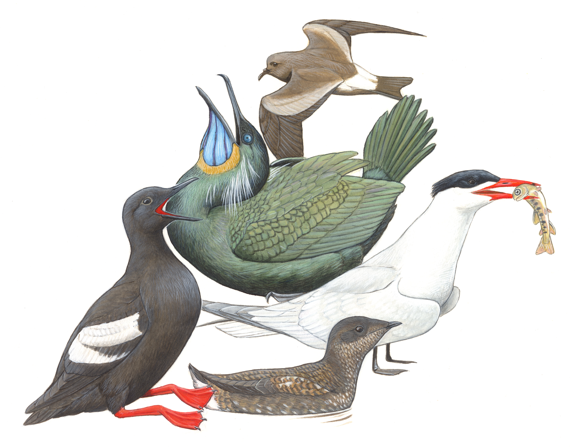 |
| Plastic from a Northern Fulmar stomach |
Research
on ingestion of microplastics by seabirds continues at the Slater Museum. With the help of Shep Thorpe, VMD, we have examined additional Northern Fulmar stomachs from 2012 from the WA and OR
coast. These were recovered by Wildlife
Center of the North Coast (WCNC), Sharnelle Fee director. There was an additional bird from Ocean
Shores, WA provided by Sheila McCartan, Nisqually NWR. The Ocean Shores bird was remarkable in
having 6.0 gm of plastic in the proventriculus and 1.04 gm in the
ventriculus (pictured). Some pieces were the size of guitar picks. There was one nurdle (labeled) which is a premanufactured plastic pellet. Typically fulmars have less than 1 gm. The Ocean Shores bird probably had enough
plastic to incapacitate it leading to its demise.
Research
continues to rely on collection of specimens by Sharnelle Fee, Wildlife Center
of the North Coast and Shep Thorpe, DVM, for dissection and separation of
stomach contents. Shep expanded
discovery to the intestines where he has discovered small particles of plastic,
parasites and clues to causes of mortality.
Professor
Peter Hodum in Biology is directing the research with students Alicia
Terepocki, Alan Brush and Olivia Feinstein.
All are presenting posters based on their research over the past year at the Pacific Seabird Conference in Portland
this month.
Abstracts
from the Pacific Seabird Group 40th
Annual Meeting 20-24
February 2013 Portland
USE
OF A DIVING PROCELLARIIFORM, THE SOOTY SHEARWATER, TO EXPAND A MARINE PLASTIC
BIODINDICATOR NETWORK
Alexander
Brush, Gary Shugart and Peter Hodum, Biology Dept & Slater Museum., University of Puget Sound,
1500 N. Warner, Tacoma, WA 98416 USA, ABrush@pugetsound.edu
There is
growing recognition that plastic pollution in our oceans has reached a critical
level and must be addressed. Seabirds, especially procellariiforms, have proven
to be a useful bioindicator of marine plastic debris through the monitoring of
their ingestion habits. To date, most efforts in documenting procellariiform
ingestion of plastic have focused on primarily surface-foraging species. There
is reason to suspect, however, that pursuit diving species may not reflect the
same plastic ingestion patterns. In this study, we examined the stomach
contents of Sooty Shearwaters (Puffinus
griseus), a species that uses both surface seizing and pursuit diving to
forage. We collected samples from 26 birds from the northern Oregon/southern
Washington region to quantify the frequency of occurrence, abundance, color and
size of plastics in the diet. Plastic was found in 69% (18 out of 26) of
specimens, which is lower than incidences of plastics in Fulmar stomachs. The abundance,
color and size of plastics found in the Shearwaters will also be presented. Due
to the differing feeding habits in Shearwaters versus Fulmars, it was expected
that plastic categorizations would produce different results in the two species
for amounts and types of plastics found. If our hope is to create a
comprehensive network of seabird bioindicators of plastic debris then our
knowledge base must be expanded to species that reflect a wide variety of
foraging guilds, as they are likely to provide unique insights into the marine
plastic issue.
NOTHERN FULMARS (FULMARIS GLACIALIS) AS BIOINDICATORS OF ENDOCRINE
DISRUPTING PLASTICIZERS IN THE MARINE SURFACE ENVIRONMENT
Olivia Feinstein*1, Erica Donnelly2, Hannah Nevins2 and Peter Hodum1,2, 1Biology Dept.,
University of Puget Sound, Tacoma, WA, 98416 USA, ofeinstein@pugetsounde.edu 2Oikonos Ecosystem
Knowledge, Benicia, CA
Many phthalates used to synthesize plastics have been identified
as endocrine disrupting chemicals (EDCs), with studies showing dramatic
deleterious effects on a variety of species as a result of exposure to growing
numbers of EDCs in the environment. The Northern Fulmar (Fulmarus glacialis)
is an opportunistic seabird which inadvertently consumes plastics as it
forages. Previous studies of Fulmars suggest that plastics are leaching EDCs
into the bird’s systems. We determined the percentage of plastics ingested by
fulmars that contain EDCs. A collaboration with the Long Marine Research Lab
allowed for geographic comparisons of EDC concentration intensities along the
West Coast. The percentage of plastics in the diet of fulmars that contained
plasticizers was below 3% in all tested regions. Plastic proportions in Alaska
differed significantly from those in California and Washington. Our analyses
confirmed that fulmars are effective bio-indicators of plastics in surface
marine environments and that the surface waters in tested regions are not
highly contaminated by plastics containing EDCs. EDC-containing plastics
typically displayed negative buoyancy and sank in seawater and may be
accumulating in benthic regions. The impacts of plastic ingestion may be a more
significant source of contaminant uptake by seabird species than previously
assumed. Additionally, there are physical consequences to species; plastics
take up volume in the stomach reducing digestive capacity which blocks nutrient
absorption.
PLASTICS IN THE PACIFIC: REGIONAL
COMPARISONS OF MARINE PLASTIC INGESTION BY NORTHERN FULMARS
Alicia Terepocki*1, Erica Donnelly2, Hannah Nevins2, Gary Shugart1 and Peter Hodum1,2, 1Biology Dept & Slater Museum., University of Puget Sound, Tacoma, WA, 98416 USA,
aterepocki@pugetsounde.edu 2Oikonos Ecosystem Knowledge, Benicia, CA
Plastic pollution is increasingly recognized as an escalating
threat to marine ecosystems. In the face of this developing issue, monitoring
ocean-wide levels of pollution has become crucial. Successful monitoring
programs utilizing Northern Fulmars (Fulmarus
glacialis) as bioindicators of marine plastic pollution have been instituted
in northern Europe and central California. As generalist and surface feeders,
fulmars are an ideal indicator due to their susceptibility to ingesting plastic
debris. In this study, we examined fulmars from northern Oregon and southern
Washington (n=89) to determine the frequency of occurrence, abundance, size and
color of plastic ingested and make inferences about the state of marine plastic
pollution in the Pacific Northwest and feeding habits of fulmars. We compared
these findings with those of birds from Alaska (n=46) and California (n=44) to
obtain information on regional differences in plastic pollution in the
northeastern Pacific. Results suggest marine plastic densities vary regionally,
in all regions plastic ingestion was prevalent.
PSG’s 40th Annual Meeting:
February 20-24, 2013 at the Portland Hilton

*
No comments:
Post a Comment